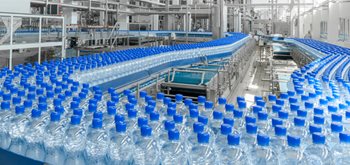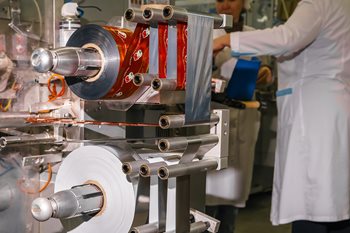In manufacturing, having your data in a single, centralized repository is a beautiful thing. I cannot emphasize enough the importance of centralizing your data. The benefits are many, and we’ll delve into the three major ones in this blog. The drawbacks, quite frankly, are non-existent. After considerable thought, I’ve determined that there’s really
no reason not to have your manufacturing quality data in one place.
And every reason to do so.
Sounds dramatic. But I emphasize for a very good reason: It’s an exciting aspect of
InfinityQS quality software products. It’s a differentiator. It truly puts us head and shoulders above the rest. Allow me to explain…as I look to the benefits and count the ways in which we can help you attain a bird’s eye view of your entire enterprise, see the big picture of your manufacturing processes, and soar above
your competition.

Benefits of Centralizing Your Quality Data
As mentioned, the benefits of centralizing your quality data are many. The most valuable benefits that come to mind are these:
- Standardization
- Uniformity
- Efficiency
Standardization
Standardization makes everything easier when it comes to collecting, analyzing, and reporting on your quality data...and more powerful.
Centralizing your quality data is the easiest way to standardize. Standardizing naming conventions (product codes, feature names, lot number formats, etc.) is crucial. Not only does it ensure a common code of communication across all plants, but it supports system-to-system integration, and enables simplified high-level reporting and data analysis across all plants. And it limits the confusion that is so common in organizations today—the confusion that is the result of individual plants who do not comply with standardization in systems, naming conventions and standard operating procedures (SOPs).

When naming conventions are standardized, quality management systems can easily aggregate data across production lines and plants, providing corporate-wide quality insights that are generally impossible to uncover without standardization.
The Bird’s Eye View
When data is aggregated, you can review quality performance across production lines, shifts, facilities, and geographical distances. This bird’s eye view is critical for prioritizing quality improvement actions for your limited quality resources.
As I mentioned in a previous blog,
SPC: Hunting the Big Picture and the Big Payoff, to maximize your return on your quality system investment, “you need to focus on the big picture of what’s going on across your organization. Instead of focusing on quality problems, you need to look at data that represents quality information across multiple production lines, shifts, plants—across the entire enterprise.”

The big picture is the key. “My belief is that more companies need to focus on the big picture of extracting
manufacturing Intelligence from the quality data they have already collected. It’s not hard. You just need systems that will support shop floor, enterprise-wide data collection and a means of aggregating that data and making it easily consumable and understandable by managers, engineers, and quality professionals.” That’s where we come in.
Uniformity
Uniformity: It’s the reason a cook doesn’t taste the soup until the pot has been stirred, and the reason why we agitate a can of paint before brushing it on a wall. Product uniformity is what all companies strive to achieve. It’s a lack of product uniformity that bedevils manufacturers.
Ideally every product X a company produces should be identical—regardless which plant made it. But creating identical products is an impossibility. Variation is impossible to avoid, and no two products are ever identical. Just look at humans: so similar, and yet so incredibly unique. Identical twins? They’re never identical.
At the risk of oversimplifying, most quality improvement efforts are an attempt to either manage and reduce variation, or deal with its consequences. Understanding variation and highlighting non-uniformity is the primary job of any good quality management system. Perfection is impossible but reducing product variation to manageable levels is the objective of every quality system.
If you want to reduce your company’s product variation and enjoy the benefits of doing so (lower costs, greater customer loyalty, etc.) at more than one plant, then you’ve got to centralize all of your quality data.

When your products are uniform, particularly when they are
consistently uniform over the long run, customers will return to you. They will buy your products time and time again. By limiting product variation across your enterprise, customers come to expect that your products will work in the same way every time. If it’s a food product, your customer has an expectation of what it will taste like…because it always tastes that way.
But if the product they repeatedly purchase tastes different just one time, customers may lose faith in your company’s ability to consistently create the same tasting food product. The result? They may buy your competitor’s product next time. In these uncertain times, losing a customer is a very expensive proposition.
Minimizing variation and generating uniformity dramatically increase the probability of retaining clients; and the reward is a loyal and dedicated customer base who will keep coming back to your company time after time.
Lastly, customers don’t concern themselves with what plant made the products they buy. They simply buy your products because they work/taste/whatever as expected. When one of your customers buys your products in a different country, they expect the product to perform the same. The underlying assumption of any consumer is this: regardless of which plant the product came from, the product should be the same as the last one I purchased. Every time, the same product should just be the same.
A Quality Purpose
The bottom line? The core purpose for having a quality management system is to create uniformity. And I mean not just at the production line level, but across all your plants—from A to Z. Uniformity is the key to product and sales success, the result of reducing variation—and what all customers want.
Quality management systems are all about minimizing that variation, understanding where there's greater variation, where there’s less uniformity, so that people (operators, quality team members, engineers, etc.) can get on top of those variations, fix them, and make things more uniform.
A Personal Example
My family shares a love for a certain type of sweet and sour candy. It’s our favorite movie treat. One day at the theater we opened a bag of our favorite sweet-and-sour and we were surprised. The bag’s contents weren’t sour at all. We looked at each other and complained that it tasted nothing like it used to. “This isn’t sour at all!” we grumbled. Sure, it was just a few dollars for the package, but we were disappointed. Before I threw away the bag, though, I noticed an 800 number on the back…and so I called to register my family’s disappointment.

I started the call by stating that this really wasn’t a complaint. “We just noticed that your sweet and sour product wasn’t sour, and I wanted you to know.” They asked me to read to them the stamped number on the bag. It turned out that this was a number that indicated to them the plant, production line, and shift on which the product was made.
Most importantly, they communicated to me that the number on the back of the bag was specifically there to help them pinpoint the source of the issue and fix it, which I thought was pretty cool.
But think about it…haven’t you occasionally noticed that when you assemble a newly-purchased grill or cabinet that some of the parts just don’t quite fit? Or, sometimes the cereal or beer you regularly buy doesn’t taste like it usually does (or should)? Experiences like these are indications of significant manufacturing variations—a serious lack of uniformity. And most companies want to know about them so they can fix them. Or better, how they can be prevented.
Efficiency
So, back to our discussion of uniformity. The way you can help to ensure uniformity across your entire company is by storing all your quality data in a single repository. When you do that, you can say with certainty, “We make the same product in 26 different plants around the world. And we know which plant is making that product in the most uniform way."
Doing this is very simple when all quality data is saved in one place. It's a matter of a couple of button clicks to be able to see which plants make the same product with the least variation. It’s also easy to identify the plants that are struggling to improve uniformity.
Being able to view data across all plants and production lines provides valuable information to organizations. It enables them to easily identify which plants generate quality performance that needs to be replicated, and which plants need the help of Six Sigma teams. Whether replicating best practices or pinpointing plants that could use extra help to improve uniformity, those actions are the result of aggregated, summarized quality data.
Rather than trying to gather up a bunch of spreadsheets or paper reports of quality data from each plant every month, it’s far more efficient to review the same data from a central repository.
With software. And when identifying improvement opportunities, bigger, better, and more impactful high-level improvements can be enacted when data is analyzed from a birds-eye view.

Closing
The big three benefits to centralizing your data are standardization, uniformity, and efficiency. There are more benefits, to be sure, but for the purposes of this blog that’s where we’ll leave it today.
Let’s say you standardize naming conventions and wisely store all quality data in a single, centralized repository. Your data experts review and analyze that data weekly or monthly and come up with a list of quality and uniformity issues that can be attacked by your Six Sigma experts. If so, you’re well on your way to incorporating the most effective
continuous quality improvement activities in your operations…and that’s what keeps your products moving off the shelf, customers happy, and your bottom line black.
Take advantage of the technology at your fingertips today: contact one of our account managers (1.800.772.7978 or
via our website) for more information.